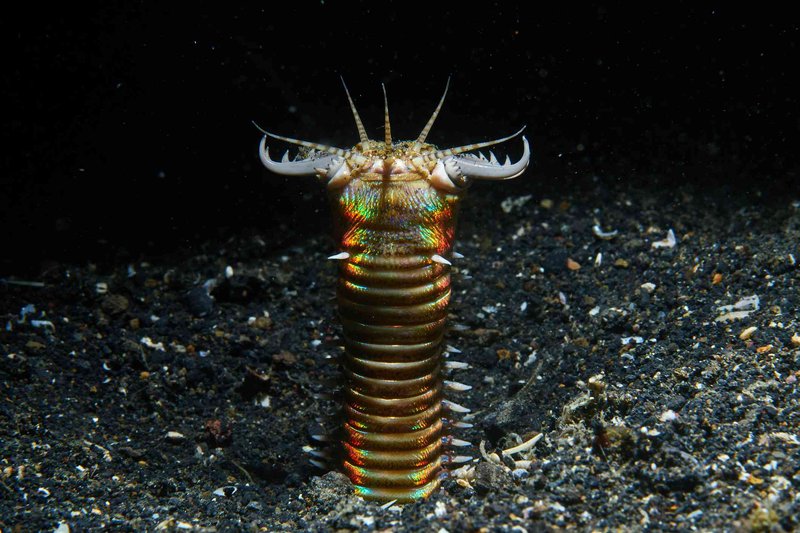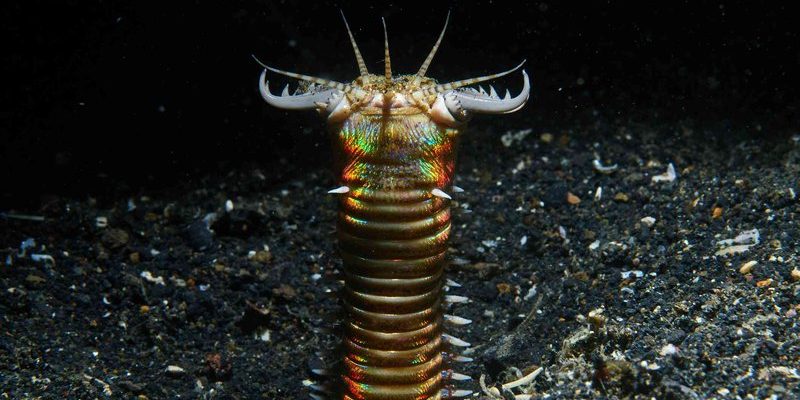
Bobbit worms are these incredible, often misunderstood predators with long, segmented bodies. They’re like the ninjas of the sand, lurking in burrows, waiting for unsuspecting meals to swim by. On the flip side, macroalgae—think of it as the sea’s version of houseplants—plays a crucial role in your typical sandbed ecosystem. Together, they form a complex relationship that’s essential for maintaining balance in their underwater habitats.
So, what makes their interaction so interesting? Let’s dive deeper!
What Are Bobbit Worms?
Bobbit worms, scientifically known as *Eunice aphroditois*, are jaw-dropping creatures that can grow up to ten feet long! These worms are known for their vibrant, colorful bodies, often green or brown, which allows them to camouflage well in the sandy seabed.
They live in burrows, using their powerful jaws to ambush prey. Imagine a lion lying in wait, ready to pounce at the perfect moment. That’s how Bobbit worms hunt. They can strike with lightning speed to catch small fish or crustaceans that wander too close to their lairs.
One of the most fascinating things about Bobbit worms is their role in the ecosystem. They help control fish populations and contribute to nutrient cycling. Without them, the balance of life in the sandy environments would be drastically affected.
Understanding Macroalgae
Now, let’s talk about macroalgae. This isn’t your typical seaweed. Macroalgae are large marine algae that come in various forms, including red, green, and brown species. They play a vital role in ocean ecosystems, much like the trees in a forest.
Think of macroalgae as the underwater gardeners. They provide **oxygen**, serve as food for numerous marine species, and even help stabilize the sandbed. They absorb sunlight and nutrients from the water, creating an environment that supports life for fish and invertebrates.
In summary, macroalgae are more than just pretty plants swaying in the currents. They’re essential for the health of the ocean and interact significantly with organisms like Bobbit worms.
The Interaction Between Bobbit Worms and Macroalgae
So, how do Bobbit worms and macroalgae interact? It’s a bit of a give-and-take relationship. Each relies on the other to some extent.
Bobbit worms create burrows in the sand, which can help keep the sand well-aerated and disturb the layers. This movement can, in turn, expose macroalgae to sunlight and nutrients necessary for growth. Imagine a gardener turning the soil to make it rich for plants to thrive. This aeration encourages the growth of macroalgae, while the algae provide a habitat for tiny organisms that, in turn, serve as food for Bobbit worms.
Additionally, the presence of macroalgae can provide some cover for Bobbit worms, making it easier for them to ambush their prey. So, while Bobbit worms are predators, they also benefit from the protective nature of the surrounding macroalgae.
Benefits of This Interaction in Sandbeds
The interaction between Bobbit worms and macroalgae is not just a unique pairing; it brings about numerous benefits for the entire ecosystem.
1. **Nutrient Cycling**: The movement of Bobbit worms helps release nutrients locked in the sand. When they burrow, they mix up sediment and expose nutrients, allowing macroalgae to flourish. This creates a healthier environment for all marine life.
2. **Support for Biodiversity**: More macroalgae means more food and shelter for smaller fish and invertebrates, which all contribute to a more vibrant ecosystem. It’s like a community where everyone plays a part.
3. **Habitat Formation**: Macroalgae can stabilize the sand around Bobbit worms’ burrows. This stability helps maintain the structure of the sandbed, which is crucial for various species that rely on that environment.
This relationship ultimately highlights the interconnectedness of marine life. It’s a reminder that even in the tiniest environments, big things are happening!
Common Misconceptions About Bobbit Worms
While Bobbit worms might seem like fearsome predators, they often get a bad rap. Here are a few misconceptions worth clarifying:
– **They Aren’t Dangerous to Divers**: While they can give a nasty bite if provoked, Bobbit worms aren’t aggressive creatures. They prefer to blend into their surroundings rather than engage with humans.
– **Not Just Destructive**: Many people view Bobbit worms as detrimental to fish populations because they prey on smaller fish. However, they help balance those populations and support healthier ecosystems.
– **Interesting Adaptations**: These worms have adapted to survive in various environments, from cold waters to tropical reefs. This resilience showcases their importance in multiple habitats.
Understanding these points helps shed light on why protecting both species is crucial.
How to Observe This Interaction
If you’re keen on exploring the wonders of Bobbit worms and macroalgae, there are a few fun ways to do so.
– **Visit a Tide Pool**: Tide pools are great spots to catch a glimpse of marine life in action. While you may not see Bobbit worms directly, you’ll likely observe the macroalgae that play a role in their habitat.
– **Snorkeling or Diving**: If you’re comfortable in the water, snorkeling in areas known for sandy beds can reveal these fascinating creatures. Look closely at the sand and you might just spot a burrow!
– **Aquariums**: Many aquariums showcase these interactions through exhibits. It’s a good way to learn more about their behaviors and habitats without getting wet!
By exploring these environments, you can observe firsthand how Bobbit worms and macroalgae coexist and thrive.
The interaction between Bobbit worms and macroalgae in sandbeds shows us just how delicate and interconnected marine ecosystems can be. They may seem like simple organisms at first glance, but they play vital roles in nutrient cycling, habitat formation, and maintaining biodiversity.
As stewards of the ocean, it’s essential to appreciate these interactions and work towards protecting their habitats. As we continue to learn more about these fascinating relationships, we can ensure future generations will also marvel at the wonders of our underwater worlds.
So next time you think about the beach, remember there’s a whole world beneath your feet—one that’s teeming with life, mystery, and beauty.

